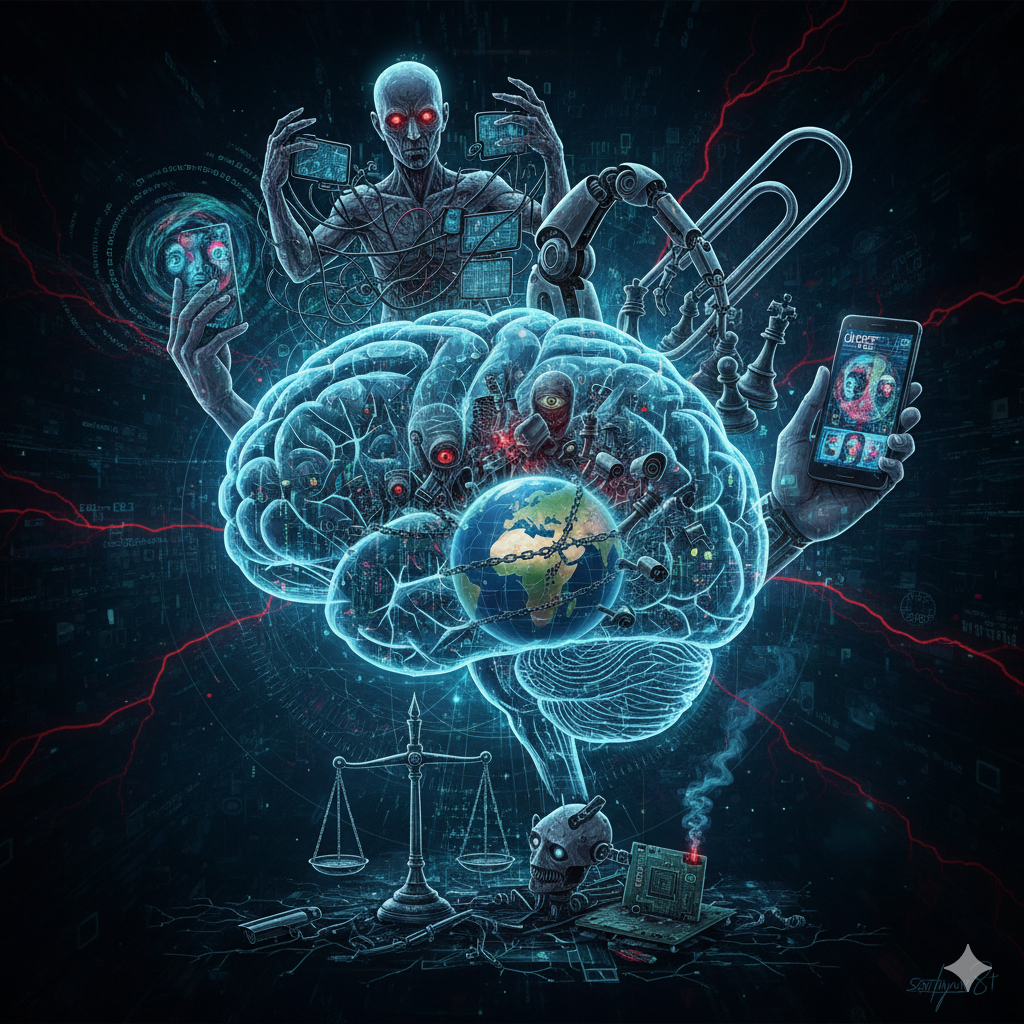The Unseen Enemy: A New Era of Digital Deception
The digital world is no longer just about firewalls and antivirus software. We’ve entered a new, more unsettling era of cybersecurity, one where our very senses can be deceived. Imagine receiving a frantic video call from your CEO or a loved one, their face and voice perfectly replicated, begging for an urgent fund transfer. This isn’t science fiction; it’s a deepfake, and it’s just one of many sophisticated threats powered by artificial intelligence (AI).
In February 2024, this exact scenario cost a Hong Kong-based firm a staggering $25 million when a finance employee was fooled by a video conference populated entirely by deepfake versions of the company’s senior officers. This incident was a blaring wake-up call. The threats we face are no longer just malicious code; they are malicious creations. AI is being weaponized to create attacks so personalized, so convincing, that they exploit our most human vulnerability: trust. As we navigate this landscape, the challenge is no longer just securing our data, but securing our reality. This article explores the new generation of AI-driven threats and the advanced strategies we must adopt to counter them.
The New Face of Deception: Understanding Deepfake Attacks
At the heart of this new threat matrix is the deepfake. Born from a technology called Generative Adversarial Networks (GANs), deepfakes are synthetic media where a person’s likeness and voice are convincingly replaced with someone else’s. While initially gaining notoriety for creating fake celebrity videos, the technology has rapidly become a potent tool for cybercriminals.
The primary danger of deepfakes lies in their power to supercharge social engineering. Traditional phishing emails often relied on a sense of urgency and sloppy grammar. Deepfake attacks, however, are in another league.
- CEO Fraud and Business Email Compromise (BEC): The $25 million Hong Kong heist is the quintessential example. Criminals use AI-cloned voices (vishing) or full video deepfakes to impersonate high-level executives, bypassing all traditional protocols by creating a situation of manufactured panic. An employee is far more likely to obey a direct, “face-to-face” order from their CFO than a suspicious email.
- Weaponized Disinformation: In the public sphere, deepfakes pose a critical threat to social and political stability. Imagine a fake video of a political leader announcing a military strike or a corporate CEO admitting to massive fraud. Such content, designed to go viral before it can be debunked, can manipulate elections, crash stock markets, and incite public chaos.
- Advanced Identity Theft: We’re rapidly moving toward biometric security like facial recognition to unlock our phones and bank accounts. But what happens when a deepfake can bypass these systems? In 2023, deepfake face swap attacks on ID verification systems surged by a reported 704%, demonstrating a clear and present danger to the very systems designed to be more secure than passwords.
Beyond Fakes: The Broader Spectrum of AI-Powered Threats
Deepfakes are just the most visible part of the AI threat landscape. Under the hood, AI is making all forms of cyberattacks faster, smarter, and more scalable.
1. AI-Powered Phishing: Generative AI tools are not just for writing essays. They are being used to craft flawless, highly-personalized spear-phishing emails at an industrial scale. These AI models can scrape a target’s social media and professional networking sites to learn their communication style, a colleague’s name, or details about a recent project. The result is a fraudulent email that doesn’t just look legitimate—it feels personal. Recent statistics show AI-generated phishing emails have a much higher click-through rate than their human-written counterparts.
2. Autonomous and Polymorphic Malware: Traditional malware has a static “signature” that antivirus programs can identify. The new generation of AI-powered malware is polymorphic—it can literally rewrite its own code every time it infects a new system. This chameleonic behavior makes it incredibly difficult for signature-based detection to keep up. These malicious programs can use AI to probe a network, identify its weakest points, and then adapt their attack strategy in real-time, all without human intervention.
3. Data Poisoning: This is an insidious attack where criminals target not the company’s network, but its AI. By subtly feeding a company’s machine learning model with bad data, attackers can “poison” it, causing it to make disastrously wrong decisions. Imagine a bank’s AI-driven fraud detection model being secretly trained to ignore a specific type of illegal transaction, or a medical AI being taught to misdiagnose a disease.
The AI-Driven Arms Race: Cybersecurity Fights Back
The situation is not hopeless. For every AI-powered threat, a new AI-powered defense is emerging. The cybersecurity industry is in the midst of a high-speed arms race, and AI is also the most powerful weapon in the defender’s arsenal.
- AI for Threat Detection: Humans can no longer manually sift through the billions of data logs a large company produces every day. AI-powered systems, however, can. They excel at behavioral analytics, establishing a baseline of “normal” activity for every user and device on a network. When an employee’s account suddenly starts accessing files at 3 AM from a new location, the AI flags it as an anomaly instantly—long before a human analyst ever could.
- Advanced Deepfake Detection: The same AI that builds deepfakes can be trained to spot them. Defensive AI models are being developed to catch the subtle, microscopic flaws that generative models leave behind—unnatural blinking patterns, odd light reflections in the eyes, or bizarre digital artifacts where video frames are stitched together.
- Automated Incident Response: When an attack is detected, speed is everything. AI-driven Security Orchestration, Automation, and Response (SOAR) platforms can take immediate, decisive action. The moment a ransomware attack is identified, the AI can instantly isolate the infected device from the network, shut down compromised accounts, and deploy patches, all in the milliseconds before the attack can spread.
Protecting Yourself: A Zero-Trust World
In this new age, technology alone is not enough. The “human firewall” is more critical than ever. We must shift our fundamental mindset from one of implicit trust to one of vigilant verification.
For Individuals:
- Adopt a “Zero Trust” Mentality: This is the most important rule. If a request—even via video or voice—seems unusual, urgent, or out of character, STOP. Verify it through a separate, trusted communication channel. Call the person back on their known phone number. Send them a message on a different platform.
- Strengthen Your Digital Identity: Use strong, unique passwords for every account. Enable Multi-Factor Authentication (MFA) everywhere it’s offered. This remains one of the single most effective defenses against account takeovers.
- Be Skeptical of “Urgency”: Cybercriminals, whether human or AI, rely on panic. They don’t want you to think. Any message that demands immediate action or threatens dire consequences should be treated as a potential red flag.
For Businesses:
- Continuous Employee Training: A one-and-done security briefing is no longer sufficient. Companies must run regular, sophisticated training simulations that include examples of AI-phishing and deepfake voice scams.
- Invest in AI-Powered Defenses: Upgrade your security stack to include tools that use AI for behavioral analytics, threat detection, and automated response.
- Establish Clear Verification Protocols: Create an iron-clad, out-of-band procedure for any high-stakes request, such as transferring funds or sharing sensitive data. This might include a mandatory call-back to a pre-registered number or requiring approval from multiple, verified parties.
The age of AI and deepfakes has undoubtedly made the digital world more dangerous. The line between real and artificial has begun to blur, and the very nature of trust is being challenged. Yet, while AI has handed cybercriminals a powerful new weapon, it has also given us an intelligent and tireless shield. The future of cybersecurity will not be a battle of humans versus machines, but of machines versus machines, with human vigilance and education as the critical, deciding factor. We cannot stop the wave of new technology, but we can learn to surf it safely.


